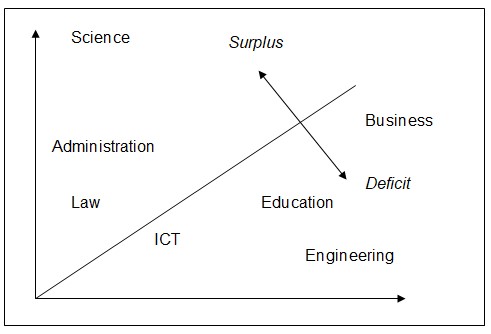Introduction
The economic system in the UAE and the countries of GCC is featured with high parameters. This is generally explained by the fact that the economy is diversified, and the consumer demand growth. As for the matters of supply and demand rates, these are featured with high investment rates, as well as the improved financial stability of the population.
Statistical Analysis
The supply and demand rate in the UAE and GCC is defined by numerous economic parameters. Hence, real estate property investment is defined as the key supply and demand derivative (Taecker, 34). By the researches by Al-Haj (559), and McLaurin (156), the property market that defines the supply and demand, is developed cyclically. However, the additional development impulse towards the market development is made by the development of international property market development. As it is stated by Cordesman (207):
There are also not enough re-sale properties completed and available for re-sale On the other hand, the outlook for future supply is for a considerable expansion. Local agent Asteco reckons 84,000 new units over the next three years. Now 16,000 new residents arrived in Dubai in the first quarter of 2010, according to the latest figures. That would imply an annual demand for around 20,000 units, assuming that everyone was accommodated in a new unit, or resulted in somebody else moving into one.
In the light of this fact, it should be emphasized that the actual importance of the real estate market for the demand and supply analysis is explained by the fact that the real estate market is one of the most influential, and defines the rates of supply and demand curves.
The oil supply and demand of the GCC group is defined by the overall economic situation in the world, and by the growth of the oil market. As is emphasized in the research by Makhal (125), the oil supply and demand forecasts are generally used for the overall economic analysis of the GCC economic systems. Hence, it is stated that global consumption of oil will increase in 2011 by 1.5 million barrels, which will cause the increased demand and supply levels in the counties oil exporters. (Anthony, 148)
The graph below represents the actual spread of demand and supply levels in different spheres.

The demand and supply capacity rate is based on the economic parameters of the UAE, as well as the countries of the GCC, and the key derivatives of these levels are associated with the key economic spheres, as well as the spheres that regulate governmental and economic administration. Since most economic researchers emphasize the importance of governmental regulation in defining the supply and demand spheres, governmental spendings may be regarded as one of the key parameters in this analysis. Additionally, the supply-demand rate is defined by governmental spendings. The graph below gives a clear representation of the matters of these rates and helps to realize the spending growth, which stimulates the growth of the supply and demand.

Conclusion
The supply and demand level of the UAE and GCC groups is defined by numerous parameters. Since the countries are less dependent on oil exports, the key role in supply and demand is played by real estate property supply, as well as governmental spending in general.
Works Cited
Al-Haj, Abdullah Juma. “The Politics of Participation in the Gulf Cooperation Council States: the Omani Consutative Council.” The Middle East Journal 50.4 (2009): 559.
Anthony, John Duke. “Special Report: Consultation and Consensus in Kuwait: The 18th GCC Summit.” Middle East Policy 1.1 (2009): 137-156.
Hamid, and Bassam Abual-Foul. “Evidence on Forecasting Inflation under Asymmetric Loss.” American Economist 54.1 (2010): 105.
Jessica. “Mirage in the Desert Oasis: Forced Labor in Dubai and the United Arab Emirates.” Harvard International Review 30.4 (2010): 287.
Anthony H. Bahrain, Oman, Qatar, and the UAE: Challenges of Security. Boulder, CO: Westview Press, 2010.
Abdul “Feature Article: Rising Oil Prices & Their Impact on the Emergers.” Emerging Markets Economic Outlook Summer 2006: 6.
Zabir. “Gulf Cooperation Council – Plus-two Ministerial Joint Settlement.” DISAM Journal of International Security Assistance Management 2007: 125.
David L., Don E. Garner,. Offshore Financial Centers, Accounting Services, and the Global Economy. Westport, CT: Quorum Books, 2010.
McLaurin, James Reagan. “A Review of the Financial Markets in the Gulf Cooperation Council (Gcc) Countries.” Journal of International Business Research 6.1 (2007): 150-165.
Kevin. “Saudi Arabia and the GCC: Exploring for Growth in a Troubled Global Economy.” Middle East Policy 6.2 (1998): 29-35.
Filip. “Remodeling Dubai: The Emirate’s Housing Market.” Harvard International Review 30.4 (2009): 124.